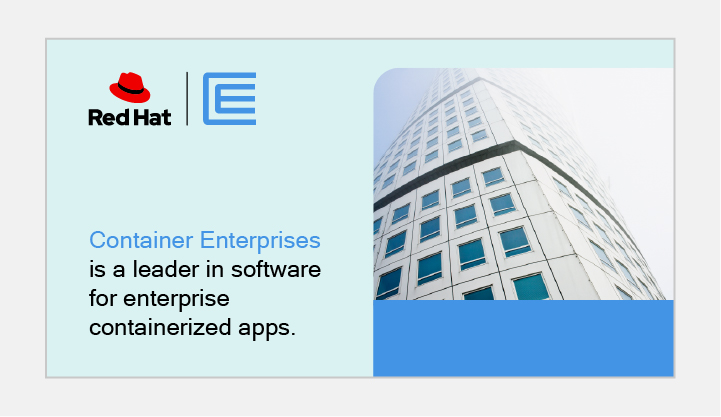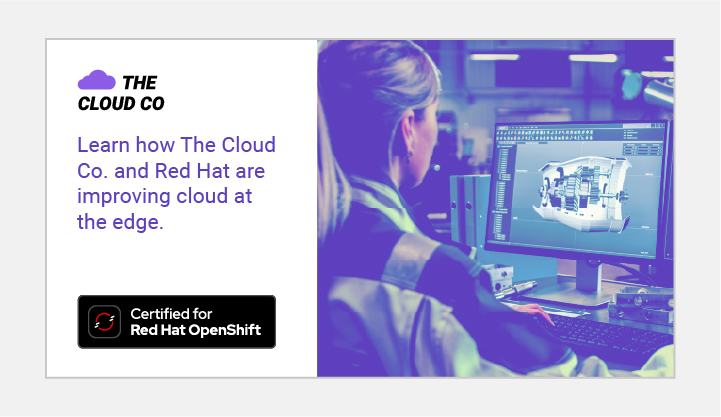Red Hat partner handbook
By working with partners, Red Hat becomes a catalyst for open innovation. We treat all partners as equals, and we aim to support our common goals while maintaining neutrality and transparency in our marketing.
Transparency in partner marketing means being clear about when a message is from Red Hat versus from a partner, as well as being clear about the relationship between Red Hat and the partner. It can be tempting to mix elements from both brands—like colors from both palettes, or a template from one brand with fonts from the other. Unfortunately, this results in muddled branding that’s less credible to customers, and can also require longer design and approval times on both sides of the partnership. Instead, always establish a lead brand for each marketing asset.
Use this handbook to determine which brand is in the lead and how to produce marketing materials accordingly.
Partner-led marketing
When a partner is the lead brand, that means the co-branded materials should look and sound like they came from the partner. The partner’s fonts, templates, color palettes, and other brand guidelines should be followed, just like any other marketing material they create. If a logo lockup is used, Red Hat comes second.
It should always be clear that partner-led materials are coming from the partner, not from Red Hat. Partners should not use marketing or branding that could confuse the customer or misrepresent their relationship to Red Hat. Depending on the asset or the partnership, it might make sense to create two versions of the asset: one led by the partner and one led by Red Hat.
When the partner is the lead brand, they’re responsible for creating marketing materials and for getting the necessary approvals from the Red Hat partner team.
Using co-brand logos in marketing
When applying a co-brand logo to a partner-led marketing asset, the partner’s logo should be first and the lockup should follow the partner’s conventions, templates, or guidelines for creating co-brand logos. If the partner does not have guidelines for creating their own co-brand logos, they can use our template.
Use the partner’s logo first in the lockup when they’re the lead brand.
Use the Red Hat logo as provided, in full color, and with enough clear space.
Follow the partner’s templates and brand guidelines.
When the logo must be one-color (like on co-branded swag with limited ink colors) use solid black, red, or white.
Do not use the Red Hat logo first in a co-brand on partner-led marketing materials.
Do not place other logos or graphics too close to the co-brand logo.
Do not use the Red Hat logo in grayscale.
Creating visuals for marketing with Red Hat
When a customer sees partner-led marketing material, it should be easy for them to tell that it’s coming from the partner, not Red Hat. That means it should look like the partner’s other ads or marketing materials, including the fonts, colors, imagery, and messaging.
Red Hat should appear second in any co-brand logo lockup and can be referenced in the headline and copy.
Use the partner’s fonts, colors, design language, and messaging.
Use a co-brand lockup with the partner’s logo first.
Do not use Red Hat brand assets or try to mimic or reproduce the Red Hat brand.
Do not use Red Hat red (other than the logo) if it’s not part of the partner’s brand palette.
Do not mix elements of the partner’s brand and the Red Hat brand.
Writing for marketing with Red Hat
There will be instances when the partnership with Red Hat needs to be communicated beyond logo placement. Any partner-led content that’s written about a partnership with Red Hat should follow these general guidelines:
- Reference the partnership with Red Hat based on who is the lead brand. If the marketing is partner-led, the content should be written in a way that indicates that the partner is leading the marketing effort in collaboration with Red Hat.
-
Recognize that there is a distinction between “products” and “solutions” when communicating to customers about a partnership. Red Hat products are just that—products. But combining a Red Hat product with a partner’s offering(s) creates a solution. When referring to what the partner is offering in addition to Red Hat’s product, please use the term “solution.”
- Remember that there are community versions for some Red Hat products, so it’s important to use the full name of the product in the first instance. After the first instance, Red Hat® Ansible® Automation Platform can be shortened to Ansible Automation Platform. Learn more on our naming and trademarks page. Learn more on our naming and trademarks page.
- Follow Red Hat trademark guidelines. The registered trademark symbol is only required on the first use of “Red Hat” as an adjective. The symbol is not necessary when using “Red Hat” to describe the company.
- Do not refer to IBM when talking about Red Hat partnerships. Red Hat is a subsidiary of IBM, but has distinct products and services.
- Do not abbreviate Red Hat product names for customer-facing materials. For example, please use Red Hat® Enterprise Linux®, never RHEL, and always use Red Hat® OpenShift® Service on AWS, never ROSA.
The following copy blocks have been created as modular tools for communicating about a Red Hat partnership. Use these examples as a guide when creating materials like website copy, press releases, social media promotions, sales enablement, thought leadership content, or slide decks. They can be used verbatim—with the partner’s information incorporated—but we encourage the use of these blocks as a foundation for using the partner’s tone, style, and language preferences.
General partner communications:
[Partner company’s name] has been a valued Red Hat partner for [number] years. Together, our [product/capability/service] along with Red Hat’s technology and expertise help our customers to innovate, differentiate, and deliver.
For partners that sell Red Hat technologies:
[Partner company’s name], a [what the partner company does], is a proud partner of Red Hat, the world’s leading provider of enterprise open source software solutions. For [number] years, we have empowered customers with Red Hat products and solutions by providing the right options, subscriptions, and expertise.
For partners that build hardware or software solutions certified by Red Hat:
[Partner company’s name] builds [what the partner company builds] that operates on [Red Hat product]. As a Red Hat partner for [number] years, our products are certified on Red Hat platforms, which means, together, we provide consistent, interoperable, and supported solutions that our customers can deploy with confidence.
For partners that provide services based on Red Hat technologies:
[Partner company’s name], a [what the partner company does], is a proud partner of Red Hat, the world’s leading provider of enterprise open source software solutions. For [number] years, we have empowered customers with Red Hat products and solutions through professional, operational, and managed service offerings including tools, training, and technical resources.
Using Red Hat product brands
When talking about a partnership with Red Hat, always use our corporate name (Red Hat) and corporate logo, not a product name or logo. When addressing a specific product or technology, a Red Hat product name can be used. Make sure to always include the full product name—for example, “Red Hat® Ansible® Automation Platform,” not just “Ansible” or an acronym. Use of product logos or technology icons is only permitted with prior approval from Red Hat.
Technical partners providing certified technologies may use either the Red Hat logo or product-specific certification buttons provided to them. Buttons are also available to show that a product or technology is available on Red Hat Marketplace.
Use the Red Hat logo, even when the copy is referring to a specific Red Hat product.
Use our full product names.
Use the provided buttons to show that the partner’s technology is available on Red Hat Marketplace or listed on Red Hat Ecosystem Catalog.
Do not refer to partnerships with one specific product.
Do not abbreviate our product names.
Do not use Red Hat product branding for partner-led materials.
Do not use a Red Hat product logo or technology icon without prior approval.
Do not co-brand with a Red Hat product logo.
Do not use a technical partner button instead of a co-brand. Only partners offering certified technologies should use a technical partner button.
Questions?
If you have questions about how to articulate your partnership with Red Hat, please contact partner-help@redhat.com



